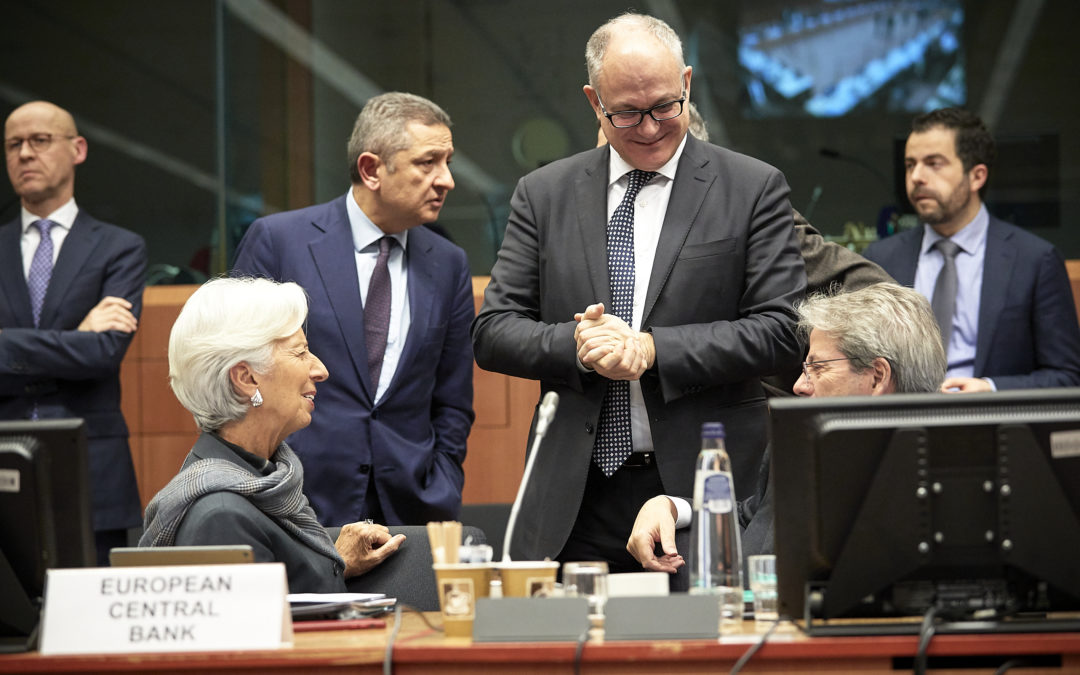By refusing to affirm the ECB’s willingness to “close spreads” on the Italian bonds market, Christine Lagarde’s mistakenly caused major indignation among citizens, politicians, and financial markets. But while Lagarde’s ambiguous comments were devastating, they mostly reveal the Eurozone’s flawed architecture.
This article was co-written with Stanislas Jourdan (executive director of Positive Money Europe).
The Covid19 outbreak is causing major distress all across Europe, with Italy being the most affected country with 1000 victims and 10.000 cases. European institutions have been quick to react. On Tuesday, March 10, EU leaders agreed during a conference call that “Flexible application of EU rules in particular as regards State aid and Stability and Growth Pact will be needed.”
This unprecedented (and so far unthinkable) agreement was followed up by the Commission. In a letter to the Italian Economy Minister Roberto Gualtieri, Commissioners Valdis Dombrovskis and Paolo Gentiloni announced that any spending made with regards to the coronavirus pandemic “will be excluded by definition from the calculation of the structural deficit”.
“We are not here to close spreads, this is not the function or the mission of the ECB”, the ECB president said, when asked by a journalist whether the ECB could support Italy further.
The statement provoked angriness and bitter reactions all across Europe but especially in Italy, among both politicians and citizens. In an unusual move and implicit reference to Lagarde’s comments, the pro-European President of the Italian Republic Sergio Mattarella went as far as saying he expected from the EU “solidarity initiatives and not that measure that can harm its action.”
To a large extent, the reaction from financial markets to Lagarde’s shaky remarks are disproportionate. First, because Lagarde herself rightly retracted her confusing words, by telling CNBC that “the high spreads we see due to coronavirus clearly impair monetary policy [and] we will use all the flexibility embedded in our asset purchase programme”, clearly hinting to the possibility for the ECB to intervene on bonds markets. Second, it is unfair to say that the ECB did nothing at all to support Italy and the rest of Europe to fight the crisis. By announcing extra 120bn of QE this year and loosening the condition to access TLTROs, the ECB will make it even easier for banks, companies and governments to be kept afloat while the economy is temporarily facing a recession. This is precisely why Lagarde’s statement is particularly harmful: by spurring doubt over the ability of the ECB to do more, the ECB president partly annulled the effectiveness of the bold policy package she announced.
The ECB’s unconstructive ambiguity
Third and foremost, Lagarde’s comments – and the reaction to it – merely reflect the never-ending fragility of the Eurozone setup where the ECB is legally prohibited to resort to “monetary financing.” As the Greek crisis revealed already 10 years ago, this rule means that the ECB is not supposed to be the “lender of last resort” to safeguard governments against speculative attacks on sovereign bond markets. At least in theory. In practice, this provision was arguably circumvented after Mario Draghi pushed the ECB to do quantitative easing and created the OMT programme. In effect, the ECB has been “closing spreads” (and rightly so) since 2011 through the SMP programme, and later with QE from 2015.
However, under a strictly legal reading, the ECB cannot intervene just because one particular government needs support to fight a medical crisis – however disastrous and unfair it is. According to the jurisprudence of the EU’s Court of Justice’ jurisprudence, the ECB can only justify market intervention when market distortions are hampering the transmission of monetary policy, or when a country signs on an ESM programme after it loses access to financial markets.
But instead of clarifying the conditions under which the ECB could forcefully help closing spreads, Lagarde’s remarks were understandably perceived as if the ECB will or cannot do nothing to help.
The ECB can help Italy – here is how
Although imperfect and tortuous, there is one way that the ECB and the Eurozone can support Italy in fighting this crisis. But the process has to start with the Italian government requesting a bailout programme to the ESM. Of course, this option is hugely unpopular in Italy, as the ESM is (rightly) perceived as an agency of austerity-minded policies, and is subject to Germany’s veto power.
But Italy has all the bargaining power it needs to ensure it will only sign on an ESM programme that has no conditions attached, and that offers very low interest rates. First, given the severity of the medical crisis, it would be utterly shameful and unjustifiable (and therefore implausible) that the EU leaders would condition such a programme to austerity conditions. Second, given that the ESM is able to borrow at negative interest rates on financial markets, there would be no decent rationale for imposing punitively expensive interest rates on the ESM loan.
Italy can formulate such a request as soon as next Monday (March 16th) as finance ministers are gathering in Brussels for their monthly Eurogroup meeting. Conveniently, one of the agenda items of this meeting is “ESM Treaty – Political endorsement of the package” – offering a possibility for ministers to agree any required last-minute change that would be required to offer generous lending conditions to Italy, and possibly for other countries too. If the Eurogroup agrees to this, the ECB (which participates in Eurogroup meetings) could swiftly activate the OMT programme.
By doing this, Italy will set a crucial precedent and lead by example to other countries. The Covid19 emergency is likely to cause similar pain in other countries of the Eurozone. Indeed, the virus knows no national boundaries, being a European problem instead of an isolated phenomenon. For this reason, cooperation is required to the greatest extent possible.
Christine Lagarde made a huge mistake that won’t be easily forgotten. Nevertheless, overreacting to her specific remarks sort of miss the point. What Lagarde’s mistake actually brought to the surface is that the Eurozone remains extremely fragile due to the weaknesses and ambiguities of its institutional setup, leaving the ECB with an unclear mandate to act or not in extreme situations.
The entire Eurozone’s stability should not rely on whether or not the current President of the ECB reiterates the “Whatever it takes” statement of her predecessor. Such a safeguard against market pressure should be guaranteed by a much stronger institutional architecture.
This is a wake-up call for all the Eurozone. This Monday, Finance Ministers have the opportunity to respond to this problem and to show real solidarity.

